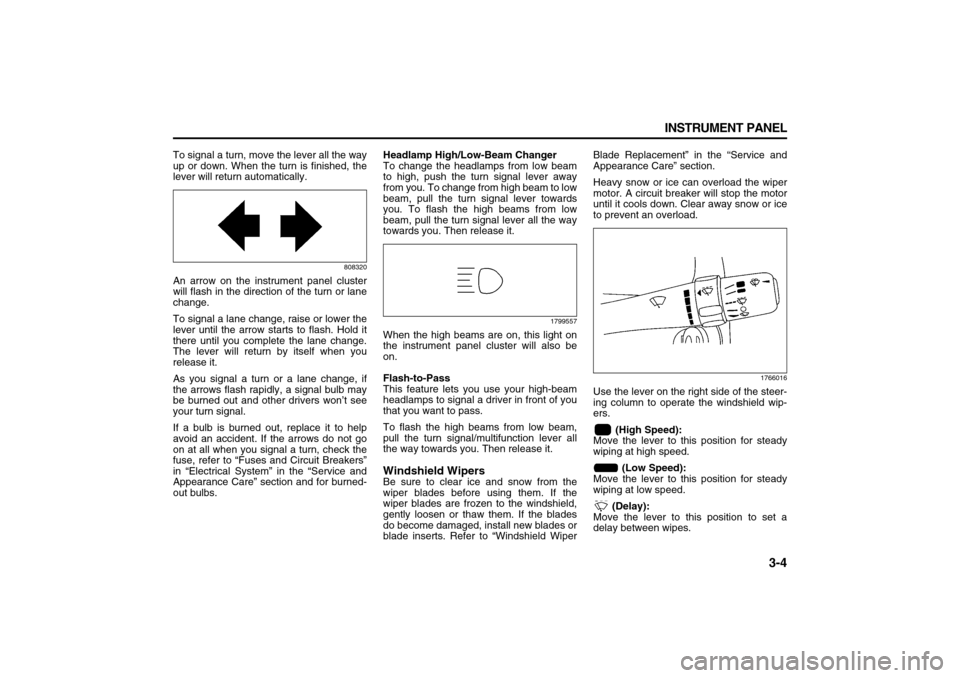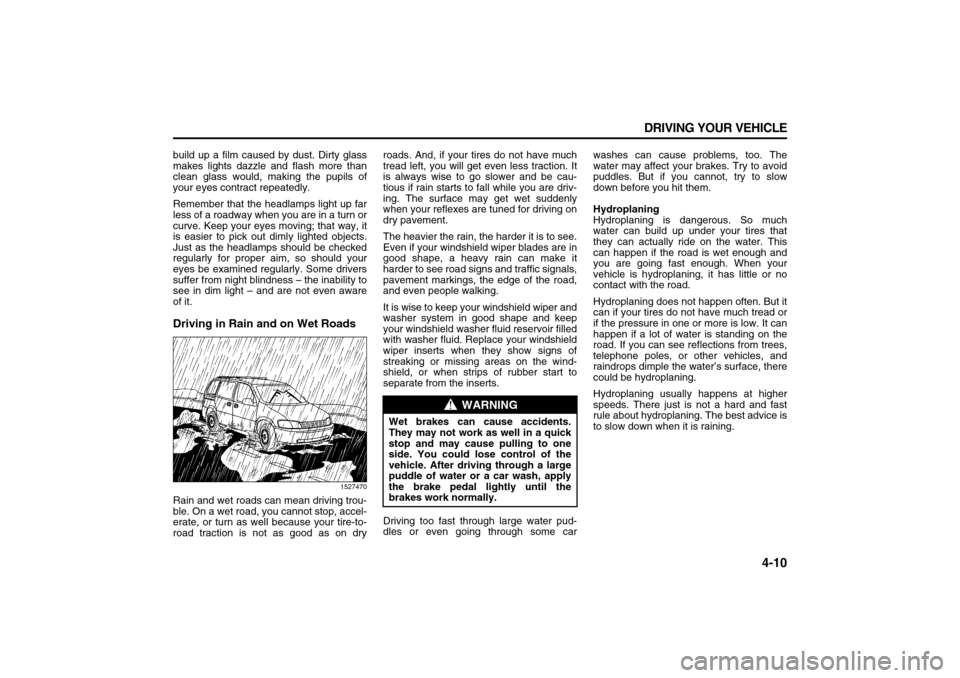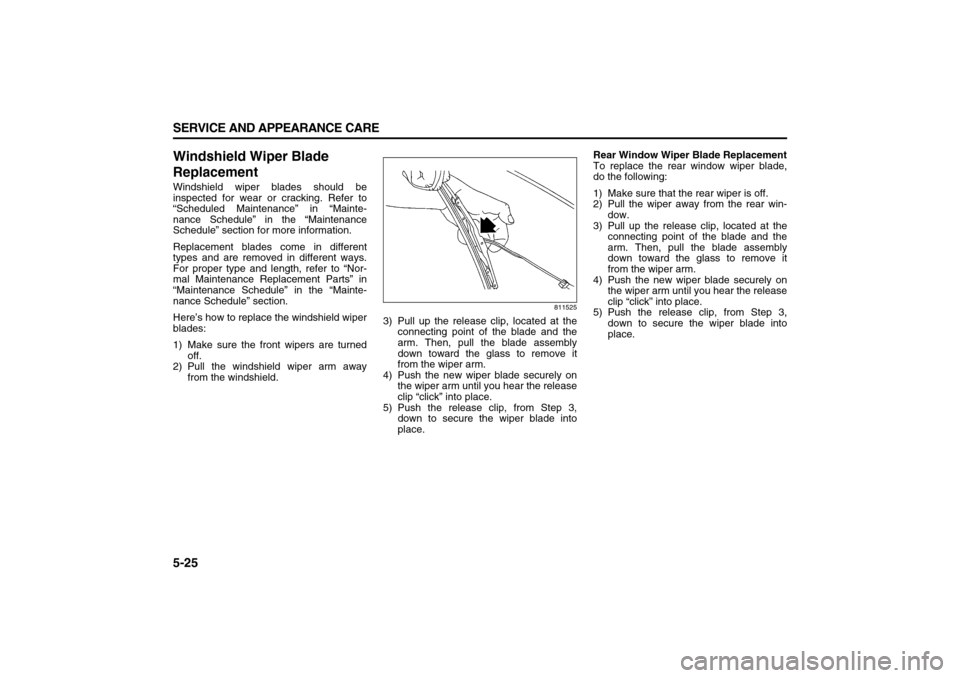wiper blades SUZUKI XL7 2007 2.G Owners Manual
[x] Cancel search | Manufacturer: SUZUKI, Model Year: 2007, Model line: XL7, Model: SUZUKI XL7 2007 2.GPages: 274, PDF Size: 6.12 MB
Page 86 of 274

3-4 INSTRUMENT PANEL
78J00-03E
To signal a turn, move the lever all the way
up or down. When the turn is finished, the
lever will return automatically.
808320
An arrow on the instrument panel cluster
will flash in the direction of the turn or lane
change.
To signal a lane change, raise or lower the
lever until the arrow starts to flash. Hold it
there until you complete the lane change.
The lever will return by itself when you
release it.
As you signal a turn or a lane change, if
the arrows flash rapidly, a signal bulb may
be burned out and other drivers won’t see
your turn signal.
If a bulb is burned out, replace it to help
avoid an accident. If the arrows do not go
on at all when you signal a turn, check the
fuse, refer to “Fuses and Circuit Breakers”
in “Electrical System” in the “Service and
Appearance Care” section and for burned-
out bulbs.Headlamp High/Low-Beam Changer
To change the headlamps from low beam
to high, push the turn signal lever away
from you. To change from high beam to low
beam, pull the turn signal lever towards
you. To flash the high beams from low
beam, pull the turn signal lever all the way
towards you. Then release it.
1799557
When the high beams are on, this light on
the instrument panel cluster will also be
on.
Flash-to-Pass
This feature lets you use your high-beam
headlamps to signal a driver in front of you
that you want to pass.
To flash the high beams from low beam,
pull the turn signal/multifunction lever all
the way towards you. Then release it.Windshield WipersBe sure to clear ice and snow from the
wiper blades before using them. If the
wiper blades are frozen to the windshield,
gently loosen or thaw them. If the blades
do become damaged, install new blades or
blade inserts. Refer to “Windshield WiperBlade Replacement” in the “Service and
Appearance Care” section.
Heavy snow or ice can overload the wiper
motor. A circuit breaker will stop the motor
until it cools down. Clear away snow or ice
to prevent an overload.
1766016
Use the lever on the right side of the steer-
ing column to operate the windshield wip-
ers.
(High Speed):
Move the lever to this position for steady
wiping at high speed.
(Low Speed):
Move the lever to this position for steady
wiping at low speed.
(Delay):
Move the lever to this position to set a
delay between wipes.
Page 168 of 274

4-10 DRIVING YOUR VEHICLE
78J00-03E
build up a film caused by dust. Dirty glass
makes lights dazzle and flash more than
clean glass would, making the pupils of
your eyes contract repeatedly.
Remember that the headlamps light up far
less of a roadway when you are in a turn or
curve. Keep your eyes moving; that way, it
is easier to pick out dimly lighted objects.
Just as the headlamps should be checked
regularly for proper aim, so should your
eyes be examined regularly. Some drivers
suffer from night blindness – the inability to
see in dim light – and are not even aware
of it.Driving in Rain and on Wet Roads
1527470
Rain and wet roads can mean driving trou-
ble. On a wet road, you cannot stop, accel-
erate, or turn as well because your tire-to-
road traction is not as good as on dryroads. And, if your tires do not have much
tread left, you will get even less traction. It
is always wise to go slower and be cau-
tious if rain starts to fall while you are driv-
ing. The surface may get wet suddenly
when your reflexes are tuned for driving on
dry pavement.
The heavier the rain, the harder it is to see.
Even if your windshield wiper blades are in
good shape, a heavy rain can make it
harder to see road signs and traffic signals,
pavement markings, the edge of the road,
and even people walking.
It is wise to keep your windshield wiper and
washer system in good shape and keep
your windshield washer fluid reservoir filled
with washer fluid. Replace your windshield
wiper inserts when they show signs of
streaking or missing areas on the wind-
shield, or when strips of rubber start to
separate from the inserts.
Driving too fast through large water pud-
dles or even going through some carwashes can cause problems, too. The
water may affect your brakes. Try to avoid
puddles. But if you cannot, try to slow
down before you hit them.
Hydroplaning
Hydroplaning is dangerous. So much
water can build up under your tires that
they can actually ride on the water. This
can happen if the road is wet enough and
you are going fast enough. When your
vehicle is hydroplaning, it has little or no
contact with the road.
Hydroplaning does not happen often. But it
can if your tires do not have much tread or
if the pressure in one or more is low. It can
happen if a lot of water is standing on the
road. If you can see reflections from trees,
telephone poles, or other vehicles, and
raindrops dimple the water’s surface, there
could be hydroplaning.
Hydroplaning usually happens at higher
speeds. There just is not a hard and fast
rule about hydroplaning. The best advice is
to slow down when it is raining.
WARNING
Wet brakes can cause accidents.
They may not work as well in a quick
stop and may cause pulling to one
side. You could lose control of the
vehicle. After driving through a large
puddle of water or a car wash, apply
the brake pedal lightly until the
brakes work normally.
Page 170 of 274

4-12 DRIVING YOUR VEHICLE
78J00-03E
The most important advice on freeway
driving is: Keep up with traffic and keep to
the right. Drive at the same speed most of
the other drivers are driving. Too-fast or
too-slow driving breaks a smooth traffic
flow. Treat the left lane on a freeway as a
passing lane.
At the entrance, there is usually a ramp
that leads to the freeway. If you have a
clear view of the freeway as you drive
along the entrance ramp, you should begin
to check traffic. Try to determine where you
expect to blend with the flow. Try to merge
into the gap at close to the prevailing
speed. Switch on your turn signal, check
your mirrors, and glance over your shoul-
der as often as necessary. Try to blend
smoothly with the traffic flow.
Once you are on the freeway, adjust your
speed to the posted limit or to the prevail-
ing rate if it is slower. Stay in the right lane
unless you want to pass.
Before changing lanes, check your mirrors.
Then use your turn signal.
Just before you leave the lane, glance
quickly over your shoulder to make sure
there is not another vehicle in your blind
spot.
Once you are moving on the freeway,
make certain you allow a reasonable fol-
lowing distance. Expect to move slightly
slower at night.When you want to leave the freeway, move
to the proper lane well in advance. If you
miss your exit, do not, under any circum-
stances, stop and back up. Drive on to the
next exit.
The exit ramp can be curved, sometimes
quite sharply. The exit speed is usually
posted.
Reduce your speed according to your
speedometer, not to your sense of motion.
After driving for any distance at higher
speeds, you may tend to think you are
going slower than you actually are.
Before Leaving on a Long TripMake sure you are ready. Try to be well
rested. If you must start when you are not
fresh – such as after a day’s work – do not
plan to make too many miles that first part
of the journey. Wear comfortable clothing
and shoes you can easily drive in.
Is your vehicle ready for a long trip? If you
keep it serviced and maintained, it is ready
to go. If it needs service, have it done
before starting out. Of course, you will find
experienced and able service experts in
dealerships all across North America.
They will be ready and willing to help if you
need it.Here are some things you can check
before a trip:
Windshield Washer Fluid:
Is the reservoir full? Are all windows
clean inside and outside?
Wiper Blades:
Are they in good shape?
Fuel, Engine Oil, Other Fluids:
Have you checked all levels?
Lamps:
Are they all working? Are the lenses
clean?
Tires:
They are vitally important to a safe, trou-
ble-free trip. Is the tread good enough for
long-distance driving? Are the tires all
inflated to the recommended pressure?
Weather Forecasts:
What is the weather outlook along your
route? Should you delay your trip a short
time to avoid a major storm system?
Maps:
Do you have up-to-date maps?
Highway HypnosisIs there actually such a condition as high-
way hypnosis? Or is it just plain falling
asleep at the wheel? Call it highway hyp-
nosis, lack of awareness, or whatever.
There is something about an easy stretch
of road with the same scenery, along with
the hum of the tires on the road, the drone
of the engine, and the rush of the wind
against the vehicle that can make you
sleepy. Do not let it happen to you! If it
Page 209 of 274

5-25 SERVICE AND APPEARANCE CARE
78J00-03E
Windshield Wiper Blade
ReplacementWindshield wiper blades should be
inspected for wear or cracking. Refer to
“Scheduled Maintenance” in “Mainte-
nance Schedule” in the “Maintenance
Schedule” section for more information.
Replacement blades come in different
types and are removed in different ways.
For proper type and length, refer to “Nor-
mal Maintenance Replacement Parts” in
“Maintenance Schedule” in the “Mainte-
nance Schedule” section.
Here’s how to replace the windshield wiper
blades:
1) Make sure the front wipers are turned
off.
2) Pull the windshield wiper arm away
from the windshield.
811525
3) Pull up the release clip, located at the
connecting point of the blade and the
arm. Then, pull the blade assembly
down toward the glass to remove it
from the wiper arm.
4) Push the new wiper blade securely on
the wiper arm until you hear the release
clip “click” into place.
5) Push the release clip, from Step 3,
down to secure the wiper blade into
place.Rear Window Wiper Blade Replacement
To replace the rear window wiper blade,
do the following:
1) Make sure that the rear wiper is off.
2) Pull the wiper away from the rear win-
dow.
3) Pull up the release clip, located at the
connecting point of the blade and the
arm. Then, pull the blade assembly
down toward the glass to remove it
from the wiper arm.
4) Push the new wiper blade securely on
the wiper arm until you hear the release
clip “click” into place.
5) Push the release clip, from Step 3,
down to secure the wiper blade into
place.
Page 234 of 274

5-50 SERVICE AND APPEARANCE CARE
78J00-03E
The best way to preserve the vehicle’s fin-
ish is to keep it clean by washing it often
with lukewarm or cold water.
Do not wash the vehicle in the direct rays
of the sun. Use a car washing soap. Do not
use strong soaps or chemical detergents.
Be sure to rinse the vehicle well, removing
all soap residue completely. Approved
cleaning products can be obtained from
your dealer. Refer to “Vehicle Care/
Appearance Materials” in this section. Do
not use cleaning agents that are petroleum
based, or that contain acid or abrasives.
All cleaning agents should be flushed
promptly and not allowed to dry on the sur-
face, or they could stain. Dry the finish with
a soft, clean chamois or an all-cotton towel
to avoid surface scratches and water spot-
ting.
High pressure car washes may cause
water to enter the vehicle.Cleaning Exterior Lamps/LensesUse only lukewarm or cold water, a soft
cloth and a car washing soap to clean
exterior lamps and lenses. Follow instruc-
tions under “Washing Your Vehicle” in this
section.Finish CareOccasional waxing or mild polishing of the
vehicle by hand may be necessary to
remove residue from the paint finish.
Approved cleaning products can be
obtained from your dealer. Refer to “Vehi-cle Care/Appearance Materials” in this
section.
The vehicle has a basecoat/clearcoat paint
finish. The clearcoat gives more depth and
gloss to the colored basecoat. Always use
waxes and polishes that are non-abrasive
and made for a basecoat/clearcoat paint
finish.
Foreign materials such as calcium chloride
and other salts, ice melting agents, road oil
and tar, tree sap, bird droppings, chemi-
cals from industrial chimneys, etc., can
damage the vehicle’s finish if they remain
on painted surfaces. Wash the vehicle as
soon as possible. If necessary, use non-
abrasive cleaners that are marked safe for
painted surfaces to remove foreign matter.
Exterior painted surfaces are subject to
aging, weather, and chemical fallout that
can take their toll over a period of years.
To help keep the paint finish looking new,
keep the vehicle in a garage or covered
whenever possible.
Windshield and Wiper BladesIf the windshield is not clear after using the
windshield washer, or if the wiper blade
chatters when running, wax, sap, or other
material may be on the blade or wind-
shield.
Clean the outside of the windshield with a
glass cleaning liquid or powder and water
solution. The windshield is clean if beads
do not form when it is rinsed with water.
Grime from the windshield will stick to the
wiper blades and affect their performance.
Clean the blade by wiping vigorously with
a cloth soaked in full-strength windshield
washer solvent. Then rinse the blade with
water.
Check the wiper blades and clean them as
necessary; replace blades that look worn.Aluminum WheelsKeep the wheels clean using a soft clean
cloth with mild soap and water. Rinse with
CAUTION
Machine compounding or aggres-
sive polishing on a basecoat/
clearcoat paint finish may damage it.
Use only non-abrasive waxes and
polishes that are made for a
basecoat/clearcoat paint finish on
your vehicle.
CAUTION
If you use strong soaps, chemicals,
abrasive polishes, cleaners, brushes,
or cleaners that contain acid on alu-
minum or chrome-plated wheels, you
could damage the surface of the
wheel(s). The repairs would not be
covered by your warranty. Use only
SUZUKI-approved cleaners on alumi-
num or chrome-plated wheels.
Page 246 of 274

6-4 MAINTENANCE SCHEDULE
78J00-03E
Service Instruction Maintenance I Maintenance II
Inspect engine air cleaner fil-
ter. If necessary, replace filter. Refer to “Engine Air Cleaner/Filter” in “Checking Things Under the
Hood” in the “Service and Appearance Care” section.
If you drive regularly under dusty conditions, inspect the filter at
each engine oil change.•
Inspect suspension and steer-
ing components. Visually inspect front and rear suspension and steering system for
damaged, loose, or missing parts, signs of wear.
Inspect power steering cables for proper hook-up, binding,
cracks, chafing, etc. (if equipped).•
Inspect engine cooling sys-
tem. Visually inspect hoses and have them replaced if they are
cracked, swollen, or deteriorated.
Inspect all pipes, fittings and clamps; replace parts as needed.
To help ensure proper operation, a pressure test of the cooling
system and pressure cap and cleaning the outside of the radiator
and air conditioning condenser is recommended at least once a
year.•
Inspect wiper blades. Visually inspect wiper blades for wear or cracking.
Replace wiper blades that appear worn or damaged or that streak
or miss areas of the windshield.•
Inspect restraint system com-
ponents. Make sure the safety belt reminder light and all your belts, buck-
les, latch plates, retractors, and anchorages are working properly.
Look for any other loose or damaged safety belt system parts.
If you see anything that might keep a safety belt system from
doing its job, have it repaired.
Have any torn or frayed safety belts replaced.
Also look for any opened or broken airbag coverings, and have
them repaired or replaced.
The airbag system does not need regular maintenance.•
Page 251 of 274

6-9 MAINTENANCE SCHEDULE
78J00-03E
Service Instruction Maintenance
Inspect engine air cleaner fil-
ter. If necessary, replace filter. Refer to “Engine Air Cleaner/Filter” in “Checking Things Under the Hood” in the
“Service and Appearance Care” section.
If you drive regularly under dusty conditions, inspect the filter at each engine oil
change.•
Inspect suspension and steer-
ing components. Visually inspect front and rear suspension and steering system for damaged, loose,
or missing parts, signs of wear.
Inspect power steering cables for proper hook-up, binding, cracks, chafing, etc.
(if equipped).•
Inspect engine cooling sys-
tem. Visually inspect hoses and have them replaced if they are cracked, swollen, or
deteriorated.
Inspect all pipes, fittings and clamps; replace parts as needed.
To help ensure proper operation, a pressure test of the cooling system and pres-
sure cap and cleaning the outside of the radiator and air conditioning condenser is
recommended at least once a year.•
Inspect wiper blades. Visually inspect wiper blades for wear or cracking.
Replace wiper blades that appear worn or damaged or that streak or miss areas of
the windshield.•
Inspect restraint system com-
ponents. Make sure the safety belt reminder light and all your belts, buckles, latch plates,
retractors, and anchorages are working properly.
Look for any other loose or damaged safety belt system parts.
If you see anything that might keep a safety belt system from doing its job, have it
repaired.
Have any torn or frayed safety belts replaced.
Also look for any opened or broken airbag coverings, and have them repaired or
replaced.
The airbag system does not need regular maintenance.•
Page 259 of 274

6-17 MAINTENANCE SCHEDULE
78J00-03E
Normal Maintenance Replacement PartsReplacement parts identified below by name, part number, or specification can be obtained from your dealer.Engine Drive Belt Routing3.6L V6 Engine
1686383Part SUZUKI Part No.
Engine Air Cleaner/Filter13780–78J00
Engine Oil Filter16510–78J00
Passenger Compartment Air Filter Element 95861–78J00
Replacement Battery33610–78J00
Spark Plugs1119A–78J00
Windshield Wiper Blades Driver’s Side – 24 inches (60.0 cm) 38340–78J00
Passenger’s Side – 19 inches (47.5 cm) 38340–78J10
Rear – 13.0 inches (33.0 cm) 38820–78J00
Page 273 of 274

8-6 INDEX
78J00-03E
Vehicle Identification
...........................................................5-52
Vehicle Identification Number
............................................7-1
Vehicle Identification Number (VIN)
...................................5-52
WWarning Lights, Gages, and Indicators
.............................3-15
Warranties
............................................................................7-2
Washing Your Vehicle
.........................................................5-49
Weatherstrips
.......................................................................5-49
What Makes an Airbag Inflate?
..........................................1-38
What Will You See After an Airbag Inflates?
....................1-38
Wheel Alignment and Tire Balance
....................................5-36
Wheel Replacement
.............................................................5-37
When It Is Time for New Tires
............................................5-34
When Should an Airbag Inflate? ........................................1-37
Where Are the Airbags?
......................................................1-35
Where to Put the Restraint .................................................1-24
Windows
...............................................................................2-8
Windshield and Wiper Blades
............................................5-50
Windshield Washer
.............................................................3-5
Windshield Washer Fluid
....................................................5-16
Windshield Wiper Blade Replacement
..............................5-25
Windshield Wiper Fuses
.....................................................5-53
Windshield Wipers
..............................................................3-4
Winter Driving
......................................................................4-14
YYour Driving, the Road, and Your Vehicle
........................4-1
Your Vehicle and the Environment
....................................6-1